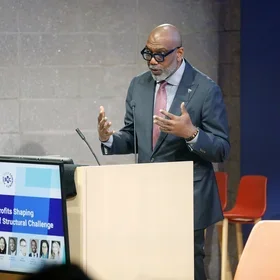By Steven Cohen, Ph.D., Director of the M.S. in Sustainability Management program, School of Professional Studies
Half a century ago, when the earth supported about half of today’s eight billion population of humans and EPA was only five years old, we began the task of implementing new laws designed to clean up our air, water, and land. To reduce pollution, we needed to measure it and understand its causes and impacts. While we always had more money and people focused on understanding the human body and medical research, a small number of scientists studied earth systems science. The U.S. federal government funded much of this research, and the data from earth observation was widely shared so that scientists all over the planet could understand the earth’s conditions. The Trump administration’s war on university science is impacting research in medical science in profound and destructive ways, but the funding supplied by drug and medical equipment companies, along with clinical medical care, will ensure that some medical research capacity is retained. Much will be lost, but some will be saved. The same cannot be said for environmental and ecological science. Funding from NOAA, NASA, EPA, and the Department of Energy is being eliminated, and the fragile funding base of earth observation is causing the collapse of this critical area of research. Studying and fixing the planet has far less monetary payoff than studying and fixing human health.
Not only are university-based researchers being defunded, but government earth observation itself is being reduced. According to reporting by Rebecca Dzombak in last week’s New York Times:
“The National Atmospheric and Oceanic Administration has said that in the next few days it will stop providing data from satellites that have been helping hurricane forecasters do their jobs for decades, citing “recent service changes” as the cause. The satellites are jointly operated by NOAA and the Department of Defense as part of the Defense Meteorological Satellite Program. They are old, dating to the early 2000s, but they have reliably helped improve hurricane forecasting for decades. The data will be halted by Monday, June 30, the agency said, without giving further explanation…The satellites orbit the poles and use microwave radiation to peer inside a hurricane to reveal changes in a storm’s structure. This information is critical for accurately predicting the path of storms and detecting hurricane intensification, particularly at night. The satellites are not being decommissioned, but their data will no longer be received, processed or stored.”
The loss of data will impair weather prediction and could well impact our ability to evacuate people in danger from extreme weather events. The casual destruction of data and research is inexplicable and appears to be part of a broader trend to destroy the organizational capacity of major elements of the U.S. federal government. In this case, this appears to be an attack on the “left-wing conspiracy” of weather prediction. According to Dzombak:
“The loss of the satellite data is the latest in a string of staffing, funding and data cuts since the Trump Administration took office in January. Hundreds of employees have left the National Weather Service since the beginning of the year, forcing some local offices to shutter their doors at night.”
Cuts in weather prediction will have an immediate impact on emergency response, but the attack on environmental science is broader and deeper than the self-destructive cuts to weather prediction. It represents an attack on science disguised as an attack on policy. I suppose the idea is that ignorance is bliss. If we don’t know about a threat to human and ecosystem health, it must not exist. Sadly, reality doesn’t work that way. You can’t spin death, destruction, and disease. These are objective facts that may be subject to disinformation, but reality has a way of asserting itself. Some of the reductions in environmental research are happening now and are probably illegal usurpations of Congress’ power of the purse, but even deeper cuts are coming in Trump’s “Big, Beautiful Bill.” According to Dinah Voyles Pulver in USA Today:
“Pick any topic related to conservation, environmental protection, climate change or weather and it’s not hard to find someone concerned by the cuts the Trump administration is proposing in its quest to shrink the federal budget. In total, President Donald Trump’s proposed budget recommends chopping more than $32 billion across agencies charged with monitoring weather, oceans and the atmosphere and protecting natural and historic resources, parks and conservation lands, according to a USA TODAY analysis. The cuts echo an array of actions already taken by federal agencies and the president’s Department of Government Efficiency. The Environmental Protection Agency for example, faces a 54.5% proposed cut, taking its budget to a level last seen when Ronald Reagan was president. The proposed cuts in other environmental-related spending range from 15% to 55% across federal agencies.”
These cuts include more than research and impact programs that protect the environment as well as analyze it. All of these agencies have built their environmental protection programs on firm scientific bases that require large and well-funded research programs. Some of the cuts are part of the ideological policy-based attack on environmental justice programs. But most attack the fundamentals of earth observation and analysis. While I believe the attacks on environmental justice are unethical and unwise, one can make an argument that Trump’s campaign promised those cuts. But the cuts on basic science were not part of any campaign and represent an attack on facts and an effort to deny the reality of our degraded planet. The cuts to science and data availability are an effort to reduce information, but the cuts also extend to an effort to hide the costs of extreme weather events. According to a report this past May by Alexa St. John of the Associated Press:
“The National Oceanic and Atmospheric Administration will no longer track the cost of climate change-fueled weather disasters, including floods, heat waves, wildfires and more. It is the latest example of changes to the agency and the Trump administration limiting federal government resources on climate change… The agency said its National Centers for Environmental Information would no longer update its Billion-Dollar Weather and Climate Disasters database beyond 2024, and that its information — going as far back as 1980 — would be archived. For decades, it has tracked hundreds of major events across the country, including destructive hurricanes, hail storms, droughts and freezes that have totaled trillions of dollars in damage. The database uniquely pulls information from the Federal Emergency Management Agency’s assistance data, insurance organizations, state agencies and more to estimate overall losses from individual disasters… The move, reported Thursday by CNN, is yet another of President Donald Trump’s efforts to remove references to climate change and the impact of greenhouse gas emissions on the weather from the federal government’s lexicon and documents.”
Despite the federal government’s attempt to deny reality, the private sector does not have the luxury of operating in a fact-free environment. Insurance companies need information about risk to price their policies. Businesses relying on supply chains must build redundancies into their purchasing processes to ensure continuous production—and that requires facts about environmental and climate risks. Profits depend on information about markets and physical conditions. Private sector replacements for federal data will be found, but they will, by definition, lack the authority and consistency of governmental data sources.
The impact of less research and reporting on environmental risk is that we will operate with an incomplete understanding of those risks. That inevitability leads to more destruction and higher costs due to damage caused by risks we do not understand. The world according to political ideologues is simpler than the actual world we live in. Our economy and culture are complicated, global, and interconnected. Simplicity is attractive and reassuring, but it is rarely the way the world works. Not understanding a problem does not cause it to disappear. We are witnessing the reckless destruction of science that is central to human survival. My hope is that the other nations of the world can somehow build what we are carelessly destroying. My prayer is that the destructive ideologues destroying environmental science in America somehow come to their senses.
Views and opinions expressed here are those of the authors, and do not necessarily reflect the official position of Columbia School of Professional Studies or Columbia University.
About the Program
The Columbia University M.S. in Sustainability Management program offered by the School of Professional Studies in partnership with the Climate School provides students cutting-edge policy and management tools they can use to help public and private organizations and governments address environmental impacts and risks, pollution control, and remediation to achieve sustainability. The program is customized for working professionals and is offered as both a full- and part-time course of study.



